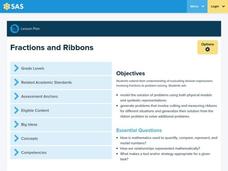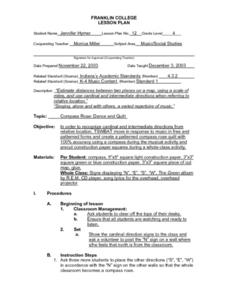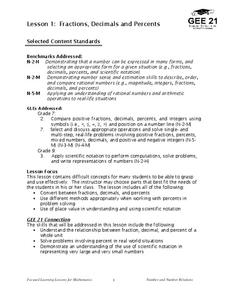Curated OER
Make Bark and Leaf Rubbings
Young scholars explore natural resources by creating art from plant materials. In this leaf rubbings lesson, students identify the plants that shed bark and leaves and discuss how it helps them survive in specific environments. Young...
Curated OER
Tangram Fractions
Students explore tangram puzzles. In this tangram fraction lesson, students read Grandfather Tang and then practice solving tangram puzzles. Students identify fractions of the pieces of the tangram puzzles and then create a design using...
Curated OER
Fraction Clue Box
Students distinguish between proper and improper fractions. They create a "Character Clue Box" that represents a fraction. Fractions are picked from a hat and then groups go outside and search for items that represent their fraction....
Helping with Math
#6: Addition and Subtraction Equations (2 of 2)
This printable contains 12 basic equations to be solved. The first one is worked out as an example, and the answers for all can be found by clicking on a "Show Answers" box found on the website. The publisher has identified this as...
Helping with Math
#5: Addition & Subtraction Equations (1 of 2)
Single-step addition or subtraction operations are applied in order to solve these 12 simple equations. An answer key is available, not so much for you, but perhaps to be used by learners as a self-correction tool. Note that the...
Helping with Math
#9: Solving Equations (1 of 2)
Twelve very simple equations are presented for learners to solve. What is the value of x? What is the value of n? Individuals apply operations to find the answers. You will find the final answers by clicking on the appropriate box at the...
Helping with Math
Solving Equations with Two-Stepping! (4 of 4)
Here are 12 two-step algebraic equations to be solved. The first problem is completed as an example to your class, but the remaining can be worked right on the page. An answer key is available by clicking on a small box at the top of the...
Helping with Math
Solving Equations with Two-Stepping! (2 of 4)
Multi-step problems are part of the progression when learning to solve equations. These 12 problems require only two steps to arrive at an answer. Either print the page out to assign as homework, or have learners write down the problems...
Helping with Math
#10: Solving Equations (2 of 2)
In this prealgebra activity, pupils perform addition, subtraction, multiplication, or division operations to solve for an unknown. There are 12 problems to be solved. Use this as a quiz to assess how well your class is grasping the skill...
Curated OER
Doing Lewis Dot Diagrams
Students observe the periodic table and draw the Lewis Dot Diagram. In this investigative lesson students construct information on several elements including the Lewis Dot Formation and take a quiz on the information they learned.
Curated OER
Coins Lesson Plan
First graders identify different coins and use their values in combination with each other to buy different objects. In this coins lesson plan, 1st graders identify the value of a quarter, dime, nickel, and penny, and use them to buy items.
Curated OER
Money
First graders explore money. For this coins value lesson, 1st graders discover the values of all the U.S. coins and practice arranging them in order to buy objects. They will play a game as a class to practice the skill of using money to...
Curated OER
Hurricanes and Climate
Students investigate maps and data to learn about the connections between hurricanes and climate. In this exploratory lesson students describe and graph the 6 regions where hurricanes happen and discuss how hurricanes have changed over...
Pennsylvania Department of Education
Fractions and Ribbons
Fifth graders solve division problems using partial quotients. In this long division lesson, 5th graders practice seeing division as a process of repeated subtraction and estimation. This lesson provides a script for the teacher.
Curated OER
Eloquent Speech
Second graders discover that oral and written communication can be improved, and made to sound more eloquent, when the following questions are addressed; Who? What? Where? When? Why? students use word processing to copy a poem using clip...
Curated OER
Prefixes, Un-, Re-, and, Dis-
Third graders identify prefixes and use prefixes correctly in sentences. They edit and change sentences containing prefixes.
Curated OER
A Statistical Look at Jewish History
Students complete their examination over the Jewish Diaspora. Using population figures, they discover the importance of percentages in exploring trends. They use their own ethnic group and determine how it is represented in the United...
Curated OER
Comparing Ratios
In this comparing ratios worksheet, students solve and complete 3 different problems using the screens shown. First, they write a ratio that compares the shaded part to unshaded part illustrated. Then, students use the same grid to...
Curated OER
Identifying Fractions 2
For this fractions practice worksheet, students examine 10 fraction graphics, write each of the fractions, and record how to say each of the fractions.
Curated OER
Identifying Fractions 3
In this fractions practice worksheet, students examine 9 fraction graphics, write each of the fractions, and record how to say each of the fractions. An example is included.
Curated OER
Lesson 56
Sixth graders practice Least Common Multiple in fractions. In this fraction lesson, 6th graders look at two different fractions and find a common denominator. They sing a song to memorize mean, median, and mode.
Curated OER
Gymnastics Lesson
Learners investigate the importance of having a healthy body by performing gymnastics. In this physical education lesson, students utilize their flexibility and body strength to perform intense physical gymnastic maneuvers with the help...
Curated OER
Compass Rose: Dance and Quilt
Fourth graders identify the cardinal directions by listening to a song entitled, "Stand," and by reviewing the lyrics to that song. They notice the cardinal directions that are posted around the classroom. They perform the motions as...
Curated OER
Fractions, Decimals, and Percents
Students connect different mathematical concepts. They create a circle graph. Students then create a question in which they collect data in order to convert fractions to decimals and decimals to percents.

























